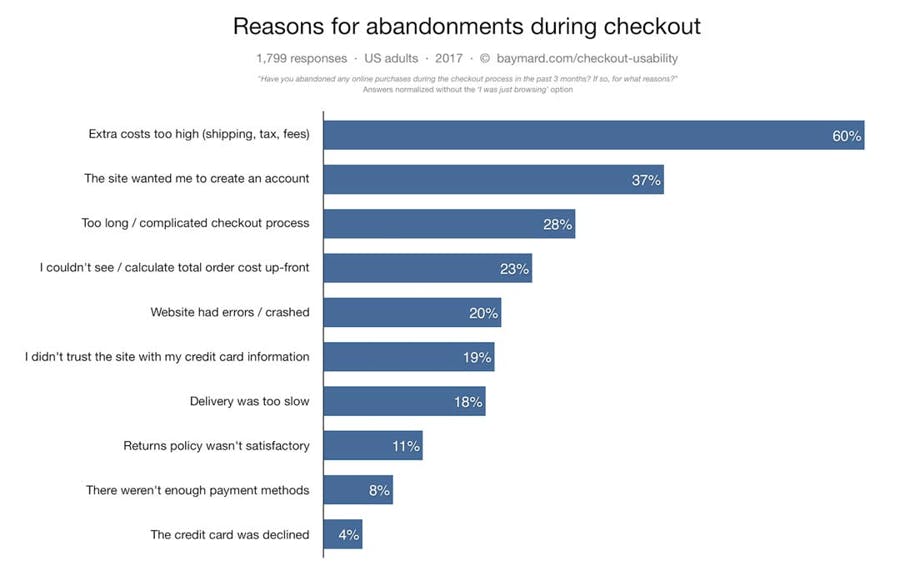Price discrepancies at checkout can scare customers away. Learn all about them here.
Studies have found over 75% of potential customers will leave a site without purchasing.
And while I’m sure unexpected power outages, cranky children, and overdrawn credit cards play some part in that number, the biggest contributor to abandoned checkouts is pricing discrepancy.
By a huge margin.

Pricing discrepancies and extra costs were the primary cause of abandoned carts for 60% of respondents in a 2017 survey from Baymard. Image via Baymard Institute
Fixing unexpected discrepancies in your pricing, then, can quickly and dramatically increase your conversion rates. Let’s go over some of the common causes of pricing discrepancies, the metrics you should be tracking to help fight cart abandonment, and the tactics you can use to eliminate pricing discrepancies and catapult your conversion rates.
But first, let’s define exactly what a pricing discrepancy is.
What is a pricing discrepancy?
A pricing discrepancy (sometimes referred to as a rate discrepancy) happens when a customer goes to the checkout page on your website and finds a different price than they expected for their order.
What causes pricing discrepancies?
The most common reason the final price is different than what a customer expected is additional shipping charges. Of course, shipping costs only affect ecommerce stores and companies selling physical goods, but SaaS companies and other online businesses can lose sales when prices fail to include taxes and handling fees as well.
Shipping costs
One of the least obvious ways to push customers away is adding a shipping cost to an order. Even if you include a note stating that shipping will be calculated and added at checkout, many customers will be confused and upset when the final price doesn’t match what was in their cart. It may be only $5, but it is one of the top ways pricing discrepancy turns off customers from checking out.
Some retailers even hide shipping costs intentionally in the hope that the lower prices will draw shoppers further down the conversion path. Of course, they pay for this strategy later with higher cart abandonment rates.
Unfactored taxes
Online stores collect sales tax based on the location of the customer and the locations in which they do business. Since these taxes can vary significantly based on customer location, they’re often not made clear until a customer goes to check out and enters their zip code.
Taxes added on to an order in checkout usually run between 7-10%, depending which state the shopper is located in. That may not seem like much, but for a $1,000 order that could add up to an extra $100 just for tax alone.
Handling fees
Another common price discrepancy among ecommerce stores is handling fees that aren’t fully disclosed until late in the checkout process. Handling fees might cover packing materials, gift wrapping, express delivery, or anything else that’s needed to send out the package. Just as with shipping costs, shifty retailers might try to disguise these costs until late in the checkout process, leading shoppers to abandon their purchase once they discover the true price.
Any other extra fees
While the above costs are more common with online stores, SaaS companies and other online businesses also experience their fair share of pricing discrepancies. Signup fees, per-user fees, implementation fees, specific payment fees (like using Stripe or PayPal), or anything else that adds unexpected costs for a customer is probably a cause of price discrepancy in your business.
Metrics to help fight pricing discrepancies
Before you can start fixing any price discrepancies on your site, you need a way of measuring how successful your efforts will be. Metrics like time on page, bounce rate, and abandoned cart rate can give you vast insights into how many people are leaving your site before checkout, and why they’re doing so.
Cart abandonment rate
Your cart abandonment rate measures the percentage of shoppers who add an item to their cart, but then leave the site before completing the purchase. Here’s how you can work it out:
Cart abandonment rate (%) = 1 - ( # completed purchases / # shopping carts created)
For example, you might find customers create 200 carts in total, but only 64 of them complete the checkout. This means your cart abandonment rate is 68%.
Cart abandonment rate is an incredibly useful metric to track in order to start capturing carts back from users who left them since it’s a leading indicator that there's a problem in the checkout process.
The main downside? Cart abandonment rate doesn’t narrow down what’s causing users to abandon their cart. Customers might leave your site due to pricing discrepancies, a confusing checkout experience, or any number of other reasons. That’s where other metrics and measurements come in handy.
Heat maps and screen recordings
Heat mapping and session recording tools like Hotjar can track and visually display shoppers’ activity on your site.
Hotjar allows you to track mouse activity on your checkout page, helping to diagnose pricing discrepancies. Image via Hotjar
You can set up a heat map on your checkout page to track visitors’ clicking and scrolling habits, and narrow down whether your high cart abandonment rate is caused by pricing discrepancies or another reason.
Time on page
Is your customer spending 10 minutes on the checkout page debating if they want to purchase? That could be a sign of pricing discrepancies. Usually, if a checkout experience is confusing, visitors will often click around until they find out how to continue. If instead, they’re simply waiting on the page for a while without doing anything before leaving the site, that’s a strong sign your pricing isn’t what they expected.
4 ways to fix price discrepancies
Lowering cart abandonment rates is an ongoing problem for most retailers. It’s easy to invest countless hours and dollars A/B testing their checkout process, tweaking user flows, and writing dunning emails while missing the simple fact that shipping costs are added too late. Fortunately, pricing discrepancies are one of the easiest cart abandonment problems to correct.
1. Optimize your pricing
This may sound like obvious advice, but most businesses won’t take it into account. Finding the right price for the products you sell is the single most important decision you’ll make, whether you’re running a SaaS company or an ecommerce store. Unfortunately, even given the benefits of value-based pricing, many online stores still cling to less profitable pricing strategies, like competitor-based or cost-plus pricing.
Customers are happy to pay a premium for products that deliver a higher value. And those same customers are more likely to buy again or maintain their subscription. Value-based pricing is a win-win.
2. Add up taxes and fees earlier
Instead of having the total price in the checkout, move it over to the cart, so customers can see how fees are adding up as they add more items.
Don’t try to sneak shipping costs and other fees in at the end of a transaction. Make all costs as clear as possible before customers add an item to their cart.
If you can't calculate this upfront—say, your shipping costs vary based on weight and location—try adding a range or other estimation to your product pages, so your customers aren't surprised by these fees at checkout.
3. Bundle shipping costs into product prices
One successful strategy is to bundle extra costs, like shipping and taxes, into the product price, then offer “free” shipping to the customer.
You make the same amount of revenue, and offering free shipping can encourage more customers to make a purchase.
4. Offer incentives
If your products require expensive shipping, look for incentives to offer customers. “Order $200+ and get free shipping” is a great way to secure your bottom line for profit while factoring in the costs.
It could push some customers to spend a lot more while eliminating the risk of a price discrepancy caused by extra shipping costs.
Take the unexpected out of pricing
Shoppers don’t like surprises. Pricing discrepancies are the most common reason customers leave your site before checking out.
Luckily, pricing discrepancies are also one of the easiest problems to correct. Take the unexpected out of your pricing—optimize around value, remove late cost surprises, and bundle costs when possible—and you’ll be well on your way to boosting your conversion rates.




